Juneau, Alaska 作者: 来源: 发布时间:2021-07-19
I.Population and Area
₋Area
Land: 2,703.98 sq mi (7,003.26 km2)
₋Population
Total: 31,974
Density: 11.82/sq mi (4.57/km2)
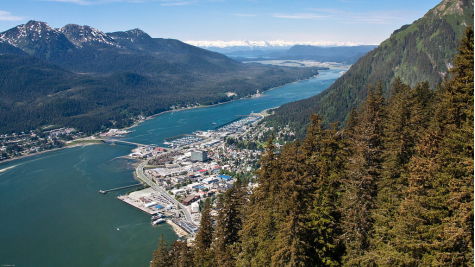
II.Natural Geography
₋The City and Borough of Juneau, commonly known as Juneau, is the capital city of Alaska. Located in the Gastineau Channel and the Alaskan panhandle, it is a unified municipality and the second-largest city in the United States by area. Juneau was named the capital of Alaska in 1906, when the government of what was then the District of Alaska was moved from Sitka as dictated by the U.S. Congress in 1900. The municipality unified on July 1, 1970, when the city of Juneau merged with the city of Douglas and the surrounding Greater Juneau Borough to form the current municipality, which is larger by area than both Rhode Island and Delaware.
₋Downtown Juneau (58°18′07″N 134°25′11″W) is nestled at the base of Mount Juneau and across the channel from Douglas Island. As of the 2010 census, the City and Borough had a population of 31,276. In 2019, the population estimate from the United States Census Bureau was 31,974, making it the second-most populous city in Alaska after Anchorage. Juneau experiences a daily influx of roughly 6,000 people from visiting cruise ships between the months of May and September.
₋The city is named after a gold prospector from Quebec, Joe Juneau, though the place was for a time called Rockwell and then Harrisburg (after Juneau's co-prospector, Richard Harris). The Tlingit name of the town is Dzántik'i Héeni ("Base of the Flounder's River," dzánti 'flounder,' –kʼi 'base,' héen 'river'), and Auke Bay just north of Juneau proper is called Áak'w ("Little lake," áa 'lake,' -kʼ 'diminutive') in Tlingit. The Taku River, just south of Juneau, was named after the cold t'aakh wind, which occasionally blows down from the mountains.
₋Juneau is unique among U.S. capitals in that there are no roads connecting the city to the rest of the state. Honolulu, Hawaii is the only other state capital not connected by road to the rest of North America. The absence of a road network is due to the extremely rugged terrain surrounding the city. This in turn makes Juneau a de facto island city in terms of transportation, since all goods coming in and out must go by plane or boat, in spite of the city's being on the Alaskan mainland. Downtown Ju neau sits at sea level, with tides averaging 16 feet (5 m), below steep mountains about 3,500 feet (1,100 m) to 4,000 feet (1,200 m) high. Atop these mountains is the Juneau Icefield, a large ice mass from which about 30 glaciers flow; two of these, the Mendenhall Glacier and the Lemon Creek Glacier, are visible from the local road system. The Mendenhall glacier has been gradually retreating; its front face is declining in width and height.
₋The Alaska State Capitol in downtown Juneau was built as the Federal and Territorial Building in 1931. Prior to statehood, it housed federal government offices, the federal courthouse and a post office. It also housed the territorial legislature and many other territorial offices, including that of the governor. Today, Juneau remains the home of the state legislature and the offices of the governor and lieutenant governor. Some other executive branch offices have moved elsewhere in the state
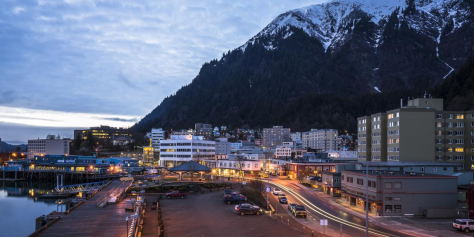
III.GDP
₋The average salary in Juneau, AK is $72k. Trends in wages decreased by -100.0 percent in Q1 2020. The cost of living in Juneau, AK is 33 percent higher than the national average. The most popular occupations in Juneau, AK are Civil Engineer, Staff Accountant, and General / Operations Manager which pay between $43k and $119k per year. The most popular employers in Juneau, AK are State of Alaska (AK), Bartlett Regional Hospital, and Juneau Youth Services.
₋Website: https://www.payscale.com/research/US/Location=Juneau-AK/Salary
IV.Industrial Characteristics
₋As the capital of Alaska, the primary employer in Juneau is government. This includes the state government, federal government (which has regional offices here, especially for resource agencies), municipal government (which includes the local airport, hospital, harbors, and school district), and the University of Alaska Southeast. State government offices and their indirect economic impact compose approximately one-quarter of Juneau's economy.
₋Another large contributor to the local economy is the tourism industry, which generates most income in the summer months. In 2005, the cruise ship industry was estimated to bring nearly one million visitors to Juneau for up to 11 hours at a time, between May and September. While cruise ships provide an economic boost to segments of the economy, not all locals are appreciative. The Juneau Public Library, built atop a parking garage along South Franklin Street near the Red Dog Saloon, was designed to take advantage of the view of and across Gastineau Channel. This view is often blocked by docking cruise ships, which have become so large that they tower over the five-story structure. Bill Ray, who lived in Juneau from 1938 to 2000 and represented the community in the Alaska Legislature from 1965 to 1987, said when he paid a return visit in 2003: "Juneau doesn't go forward. They've prostituted themselves to tourism. It looks like a poor man's Lahaina".
₋The fishing industry is still a major part of the Juneau economy, while not as strong as when the halibut schooner fleet generated considerable profits. Juneau was recently the 49th most lucrative U.S. fisheries port by volume and 45th by value. In 2004 it took in 15 million pounds of fish and shellfish, valued at 21.5 million dollars, according to the National Marine Fisheries Service. While the port of Juneau does comparatively little seafood processing compared to other towns of this size in Alaska, the hundreds of commercial fishing boats sell their fish to plants in nearby Sitka, Hoonah, Petersburg and Ketchikan. The largest fleets operating from Juneau are the gillnet and troll salmon fleets.
₋Juneau is also the home to many of the commercial fishing associations in Alaska, as they want to educate and lobby the state legislature. These associations include the Alaska Trollers Association, United Fishermen of Alaska, United Southeast Alaska Gillnetters Association, and the Southeast Alaska Seiners Association.
₋Real estate agencies, federally funded highway construction, and mining are still viable non-government local industries. Alaska Seaplanes, an airline, has its headquarters in Juneau. Highliner Construction, a general contractor is based there as well. As of Census 2010 there were 1,107 businesses with operations in Juneau borough and thus, with a population of 31,275, a per capita of roughly 28 people per business.
V.Attractions
1.Mendenhall Glacier
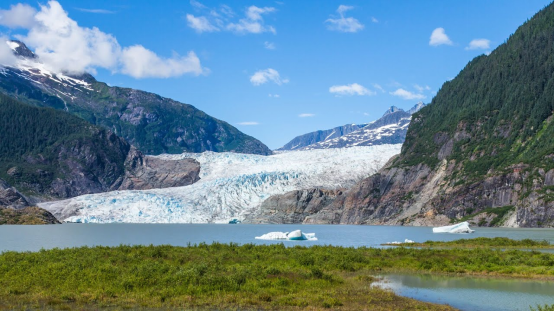
₋Mendenhall Glacier (also Sitaantaagu) is a glacier about 13.6 miles (21.9 km) long located in Mendenhall Valley, about 12 miles (19 km) from downtown Juneau in the southeast area of the U.S. state of Alaska. The glacier and surrounding landscape is protected as part of the 5,815 acres (2,353 ha) Mendenhall Glacier Recreation Area, a federally designated unit of the Tongass National Forest.
₋The Juneau Icefield Research Program has monitored the outlet glaciers of the Juneau Icefield since 1942, including Mendenhall Glacier. The glacier has also retreated 1.75 miles (2.82 km) since 1929, when Mendenhall Lake was created, and over 2.5 miles (4.0 km) since 1500. The end of the glacier currently has a negative glacier mass balance and will continue to retreat in the foreseeable future.
₋Given that average yearly temperatures are currently increasing, and the outlook is for this trend to continue, it is actually possible that the glacier might experience a period of stabilization or slight advance during its retreating march. This is because increasing amounts of warm, moist air will be carried up to the head of the icefield, where colder ambient temperatures will cause it to precipitate as snow. The increased amount of snow will feed the icefield, possibly enough to offset the continually increasing melting experienced at the glacier's terminus. However, this interesting phenomenon will fade away if temperatures continue to climb, since the head of the glacier will no longer have cold enough ambient temperatures to cause snow to precipitate.
₋Website: https://www.alaska.org/detail/mendenhall-glacier-visitor-center
2.Tongass National Forest
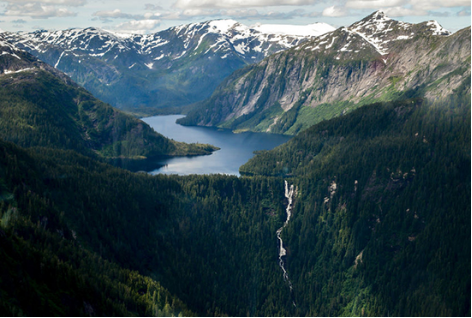
₋The Tongass National Forest in Southeast Alaska is the largest national forest in the United States at 16.7 million acres (68,000 km2). Most of its area is part of the temperate rain forest WWF ecoregion, itself part of the larger Pacific temperate rain forest WWF ecoregion, and is remote enough to be home to many species of endangered and rare flora and fauna. The Tongass, which is managed by the United States Forest Service, encompasses islands of the Alexander Archipelago, fjords and glaciers, and peaks of the Coast Mountains. An international border with Canada (British Columbia) runs along the crest of the Boundary Ranges of the Coast Mountains. The forest is administered from Forest Service offices in Ketchikan. There are local ranger district offices located in Craig, Hoonah, Juneau, Ketchikan, Petersburg, Sitka, Thorne Bay, Wrangell, and Yakutat.
₋Website: https://www.fs.usda.gov/tongass/
3.Mount Roberts Tramway
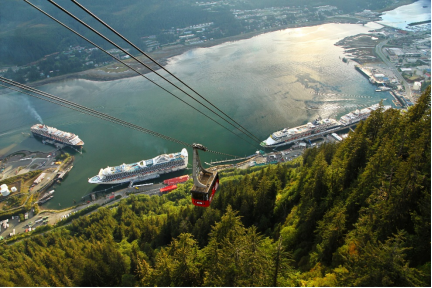
₋The Mount Roberts Tramway is an aerial tramway located just south of downtown Juneau in the U.S. state of Alaska. In operation since 1996, the tram makes a six-minute ascent of 3,819-foot (1,164 m) Mount Roberts from the cruise ship docks (just feet above sea level) to a height of about 1,800 feet (550 m). A restaurant, theater, nature center and retail shops are located at the top of the tramway, as well as connections to trails leading both up and down the mountain. One trail up the mountain leads to a large cross erected by Roman Catholic Father Brown in the early 1900s.
₋The tramway was conceived by John Heiser in 1994. Heiser, together with Bruce Booher, Marc Bond, Kevin Branson and Ron Greisen, formed Mount Roberts Development Corporation (MRDC). MRDC designed the facility, acquired the necessary land and rights-of-way, and obtained permits. Following the preliminary stages, MRDC partnered with Goldbelt, Incorporated, the ANCSA corporation for Alaska Natives in and from Juneau, to finance, construct and operate the venture. MRDC managed the partnership and oversaw construction of the tramway. The tram opened for limited operation in September 1996 and the grand opening was held in May 1997. MRDC sold its partnership interest to Goldbelt the following year. Anne Hunter, the tram's operation manager, was contracted to stay on another year as part of the sale agreement. The tram ferried nearly 160,000 people to the alpine region above downtown Juneau the summer of 1997, its first full season. It was built in 1996 at a cost of nearly $16 million (or $26 million today) and took in $3 million in revenue in its first year of operation ($4.8 million today).
₋Address: 490 S Franklin St, Juneau, AK 99801, United States
₋Phone: +1 888-461-8726
₋Website: http://mountrobertstramway.com/
VI.History
₋Long before European settlement in the Americas, the Gastineau Channel was a fishing ground for the Auke (A'akw Kwáan) and Taku tribes, who had inhabited the surrounding area for thousands of years. The A'akw Kwáan had a village and burying ground here. In the 21st century it is known as Indian Point. They annually harvested herring during the spawning season.
₋Since the late 20th century, the A'akw Kwáan, together with the Sealaska Heritage Institute, have resisted European-American development of Indian Point, including proposals by the National Park Service and the National Oceanic and Atmospheric Administration (NOAA). They consider it sacred territory, both because of the burying ground and the importance of the point in their traditions of gathering sustenance from the sea. They continue to gather clams, gumboots, grass and sea urchins here, as well as tree bark for medicinal uses. The city and state supported Sealaska Heritage Institute in documenting the 78-acre site, and in August 2016 it was listed on the National Register of Historic Places. "It is the first traditional cultural property in Southeast Alaska to be placed on the register."
₋Descendants of these indigenous cultures include the Tlingit people. Native cultures have rich artistic traditions expressed in carving, weaving, orating, singing, and dancing. Juneau has become a major social center for the Tlingit, Haida, and Tsimshian of Southeast Alaska.
₋European encounters
₋Although the Russians had a colony in the Alaska territory from 1784 to 1867, they did not settle in Juneau. They conducted extensive fur trading with Alaskan Natives of the Aleutian Islands and Kodiak.
₋The first European to see the Juneau area was Joseph Whidbey, master of the Discovery during George Vancouver's 1791–95 expedition. He and his party explored the region in July–August 1794. Early in August he viewed the length of Gastineau Channel from the south, noting a small island in mid-channel. He later recorded seeing the channel again, this time from the west. He said it was unnavigable, being filled with ice.
₋Mining era
₋After the California gold rush, miners migrated up the Pacific Coast and explored the West, seeking other gold deposits. In 1880, Sitka mining engineer George Pilz offered a reward to any local native in Alaska who could lead him to gold-bearing ore. A local native arrived with some ore, and several prospectors were sent to investigate. On their first trip to Gold Creek, they found deposits of little interest. However, Pilz sent Joe Juneau and Richard Harris back to the Gastineau Channel, directing them to Snow Slide Gulch (the head of Gold Creek). According to the Rev. Samuel Young, in his book Alaska Days with John Muir, it was their party's campsite at the creek head that Juneau and Harris decided to explore, in the summer of 1879. There they found nuggets "as large as peas and beans," in Harris' words.
₋On October 18, 1880, the two men marked a 160-acre (650,000 m2) town site where soon a mining camp sprang up. Within a year, so many miners had arrived that the camp became a village, albeit made up mostly of tents and shacks rather than substantial buildings. It was the first European American settlement founded in this territory after the United States purchased Alaska.
₋By the autumn of 1881, the village had a population of over 100 and was known as Rockwell, after Lt. Com. Charles Rockwell; later it was known as Harrisburg after prospector Richard Harris. On December 14, 1881, a miners' meeting of 72 persons decided to name the settlement Juneau, after prospector Joe Juneau.
₋Establishment of Russian Orthodox Church
₋Perhaps because of the pressure of this European encroachment, some Tlingit appealed to the Russian Orthodox Church. It had given services in northern Tlingit settlements in local languages since 1800 and 1824. One of its priests had translated scripture and liturgy into the Tlingit language in the 1830s–1840s. The Tlingit arranged for an Orthodox priest to come to their settlement in Juneau. In 1890, some 700 people converted, following chief Yees Gaanaalx and his wife of Auke Bay. The Orthodox Church Missionary Society supported the Tlingit in furnishing and constructing a church for this large congregation.
₋St. Nicholas Orthodox Church was completed in 1894 and has maintained a strong presence among the Tlingit, Serbians, and other Europeans who followed this church. The iconostasis has six large panels sent from Russia.
₋Development of mining
₋During this period, prospector and placer miner John Lemon operated in what is today the Lemon Creek area. The neighborhood that developed there was named for him by early settlers, as have been several other landmarks in Juneau.
₋Major mining operations in the Juneau mining district prior to World War II included the Treadwell Mine, The Alaska-Juneau Mine, and Alaska-Gastineau Mine.
₋By 1906, after the decline of whaling and the fur trade, Sitka, the original capital of Alaska, had become less important and the territorial legislature moved the seat of government to Juneau in accordance with a 1900 federal law. Juneau was the largest city in Alaska during the inter-war years, passing Fairbanks in the 1920 census. In the post-World War II years, it was displaced by Anchorage in 1950.
₋20th and 21st centuries
₋In 1911, the United States Congress authorized funds for construction of a capitol building for the Alaska Territory. World War I delayed construction and there were difficulties purchasing the necessary land. Citizens of Juneau donated some of the required funds, and construction began on September 8, 1929. Construction of the capitol took less than two years, and the building was dedicated as the Federal and Territorial Building on February 14, 1931. It was designed by Treasury Department architects in the Art Deco architectural style. The building was originally used by the federal government to house the federal courthouse and post office for the territory. Since Alaska gained statehood in 1959, the building has been used by the state government.
₋The Alaska Governor's Mansion was commissioned under the Public Building Act in 1910. The mansion was designed by James Knox Taylor in the Federal style. Construction was completed in 1912. The territorial governor at that time was the first governor to inhabit the mansion, and he held the first open house for citizens on January 1, 1913. The area of the mansion is 14,400 square feet (1,340 m2). It has ten bathrooms, six bedrooms, and eight fireplaces. The governor resides here when in Juneau on official business. In June 1923, President Warren G. Harding became the first president to visit Alaska. Harding visited the Governor's Mansion while Territorial Governor Scott Bone, who was appointed by Harding, was in office. Harding spoke from the porch of the mansion explaining his policies and met with attendees.
₋During World War II, more than 50 Japanese citizens and Japanese Americans residing in Juneau were evacuated to the internment camps inland as a result of Executive Order 9066—which authorized the forced removal of all ethnic Japanese away from their homes and businesses on the West Coast of the United States. The removal of Juneau's Japanese community during the war was later commemorated known as the Empty Chair Memorial in July 2014 during a dedication ceremony at the neighborhood of Capital School Park in the city.
₋Robert Atwood, then publisher of the Anchorage Times and an Anchorage "booster," was an early leader in efforts to move the capital to Fairbanks, which many in both cities resisted. Some supporters of a move wanted a new capital to be at least 30 miles (48 km) from Anchorage and Fairbanks, to prevent either city from having undue influence. Juneau has continued as the capital. In the 1970s, voters passed a plan to move the capital to Willow, a town 70 miles (110 km) north of Anchorage. But pro-Juneau people there and in Fairbanks persuaded voters also to approve a measure (the FRANK Initiative) requiring voter approval of all bondable construction costs before building could begin. Alaskans later voted against spending the estimated $900 million. A 1984 "ultimate" capital-move vote also failed, as did a 1996 vote.
₋Juneau remains the capital. Once Alaska was granted statehood in 1959, Juneau's population increased along with the growth of state government. After construction of the Alaska Pipeline in 1977, the state budget was flush with oil revenues, and it expanded programs for the people. That growth slowed considerably in the 1980s.
₋In 2005, the state demographer projected slow growth in the borough for the next twenty years. Cruise ship tourism has expanded rapidly, from approximately 230,000 passengers in 1990 to nearly 1,000,000 in 2006, as cruise lines have built more and larger ships. They sail to Juneau seven days a week over a longer season than before, but the cruising tourism is still primarily a summer industry. It provides few year-round jobs but stimulates summer employment in the city.
₋In 2010, the city was recognized as part of the "Playful City USA" initiative by KaBOOM!, created to honor cities that ensure their children have great places to play.
₋Juneau is larger in area than the state of Delaware and was, for many years, the country's largest city by area. Juneau continues to be the only U.S. state capital on an international border: it is bordered on the east by Canada. It is the U.S. state capital whose namesake was most recently alive: Joe Juneau died in 1899, a year after Otto von Bismarck, the Prussian leader for whom Bismarck, North Dakota was named.
₋The city was temporarily renamed UNO, after the card game, on April 1, 2016 (April Fool's Day). The change was part of a promotion with Mattel to draw "attention to new wild cards in [the] game".For Juneau's cooperation, Mattel donated $15,000 "to the Juneau Community Foundation in honor of late Mayor Greg Fisk."
VII.Other Information
₋Infrastructure
₋Healthcare
The city and borough is primarily served by Bartlett Regional Hospital in Juneau's Twin Lakes area. The hospital also serves the nearby remote communities of Hoonah, Haines, and Skagway. Individuals in these communities must be airlifted to the hospital via helicopter or air ambulance (ranging from a 20-minute to a 45-minute flight, depending on location).
₋Culture
₋Juneau hosts the annual Alaska Folk Festival, Juneau Jazz & Classics music festival, and Celebration, a biennial Alaska Native cultural festival.
₋Juneau has a city-owned ski resort, Eaglecrest, located on Douglas Island.
₋The city-owned Treadwell ice-skating rink is located on the south end of Douglas Island. It is named after the Treadwell Gold Mine, which is located next to the rink. The rink is open for figure skating, hockey and free open skate. From September to April; when the ice is melted it is used for rollerblading, roller hockey, tennis, basketball, concerts.
₋The city is home to Perseverance Theatre, Alaska's largest professional theater, and the non-profit Theatre in the Rough. The Juneau Symphony performs regularly. The Juneau Lyric Opera and Opera to Go are the two local opera companies. The JUMP Society hosts screenings of locally made short films two times a year.
₋Downtown Juneau has art galleries that participate in the monthly First Friday Art Walk and annual Gallery Walk held in the first week of December. The Juneau Arts & Humanities Council coordinates events and operates the Juneau Arts & Culture Center, which features a community center, gallery and lobby shop. The University of Alaska Southeast Campus offers lectures, concerts, and theater performances. Sealaska Heritage, the nonprofit affiliate of the Sealaska Corporation, operates The Walter Soboleff Building which is decorated by carvings and hosts cultural exhibits.
₋Notable artists from Juneau include painter Rie Muñoz, printmaker Dale DeArmond, violinists Linda Rosenthal and Paul Rosenthal, Alaska Native carver and painter James Schoppert, playwright and painter Elliott Pillifant, playwright and filmmaker Gab Cody, theatre director Molly Smith, filmmaker Chuck D. Keen, writer and photographer Lynn Schooler, who authored The Blue Bear, and Janet Gardner, Singer of the hard rock band Vixen.
VIII.Contact Information
₋Government
Mayor: Beth Weldon
Governing body: Assembly
₋City Hall
Address: 155 S. Seward Street, Juneau AK 99801
Phone: 907.586.5240
Fax: 907.586.5385
